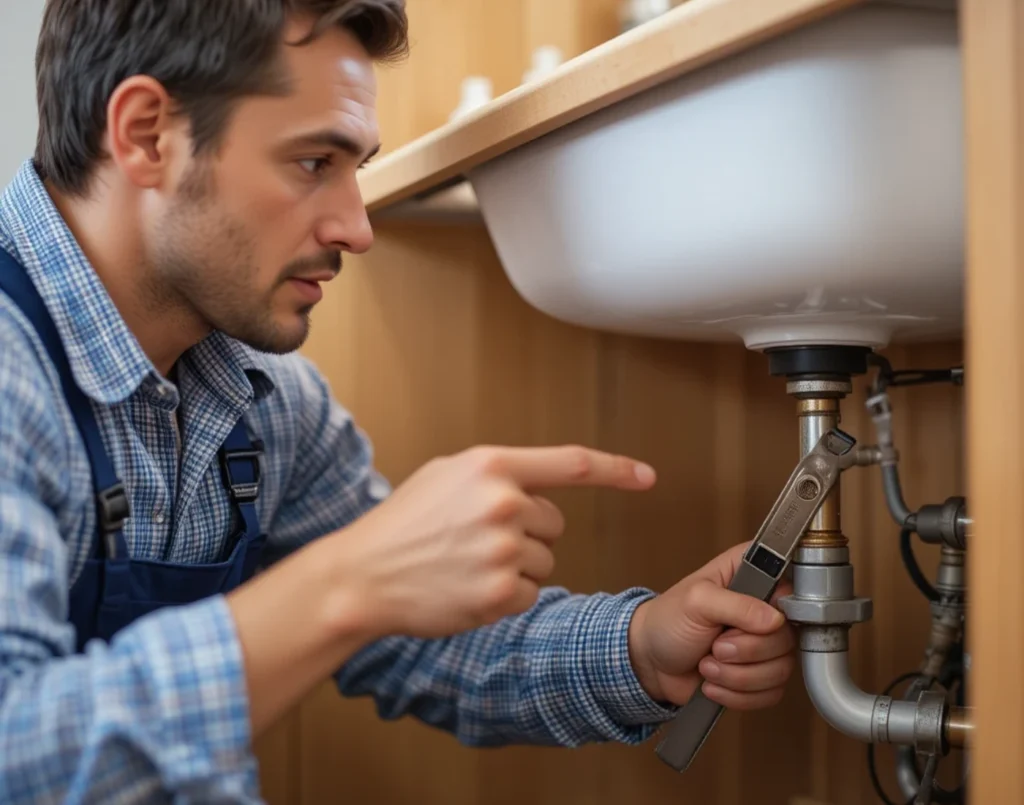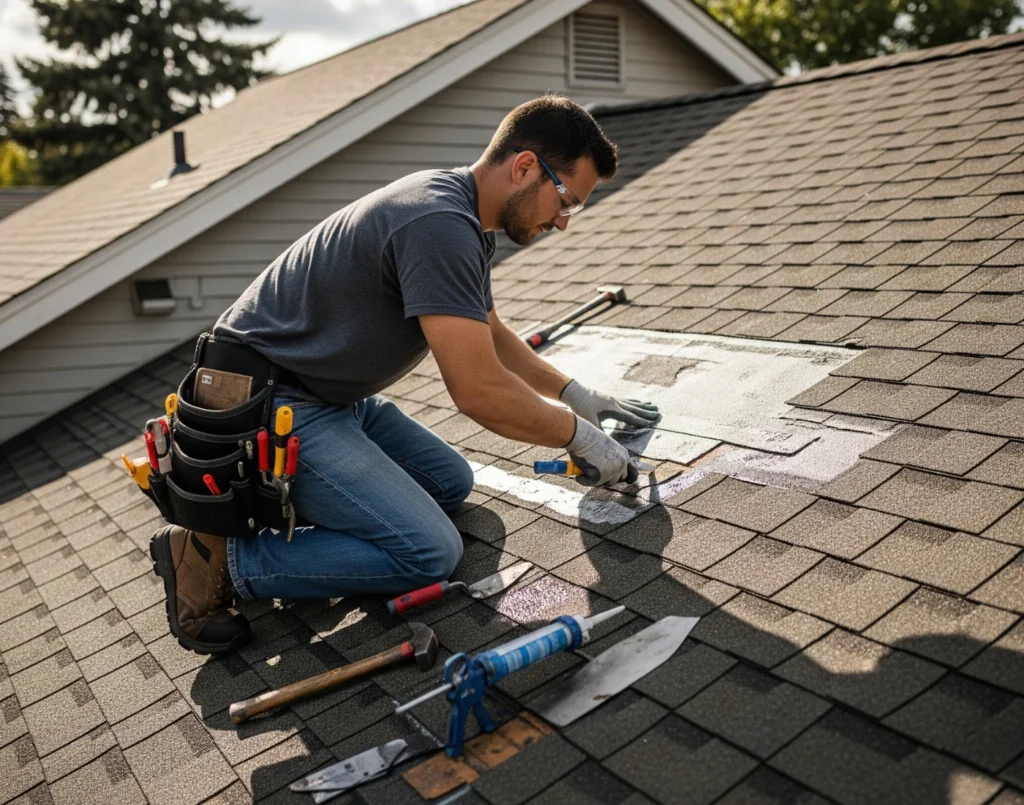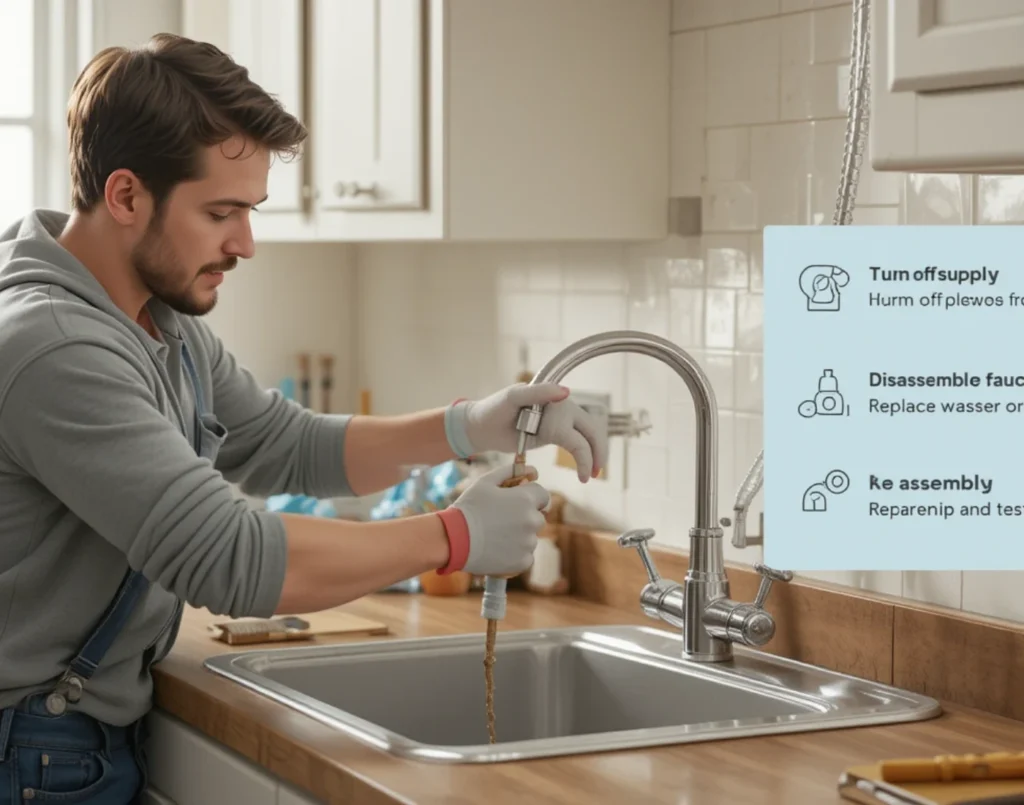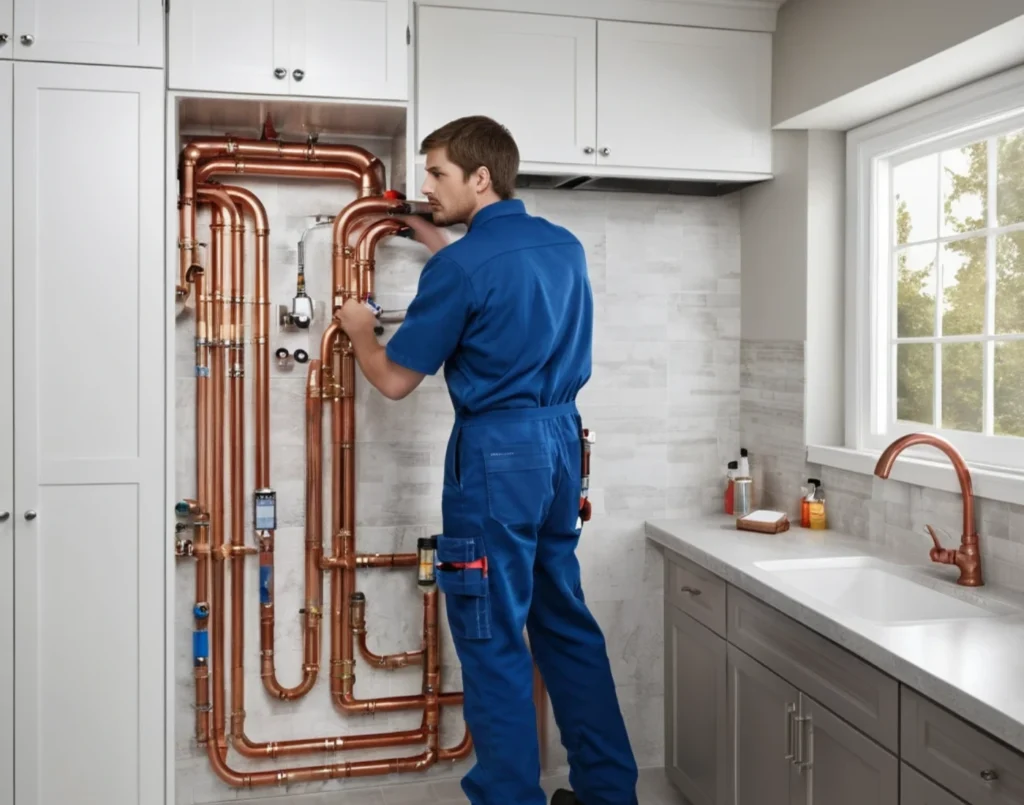A new roof is a big investment, often costing $15,000 to $30,000 or more. When you spend so much time protecting your home, you don’t want costly issues right after. After 20 years in roofing, I’ve witnessed many homeowners struggle. A good warranty can save them thousands and reduce stress.
Your roofing warranty is more than just a piece of paper. It protects you from material defects, installation mistakes, and expensive repairs. Many homeowners get their warranty but don’t fully understand what it covers or how to keep it valid.
This guide covers roof repair warranties. It explains the types, what they cover, and how to make claims. Starting a roofing project or checking coverage can help you make smart choices. This protects your investment.

Understanding Roof Repair Warranties
Definition and Purpose
A roofing warranty is a promise. It protects homeowners against defects in materials and installation. It’s like insurance for your roof.
A roofing warranty does more than protect your money. It shows the company’s trust in their work and the quality of their materials. Businesses that offer full warranties frequently maintain higher standards and produce better outcomes.
Key Benefits
Roofing warranties are essential for homeowners, offering important financial protection. A broken part or an installation error could cost you the entire roof project without a warranty. I’ve watched families discover big leaks just six months after installation. Their warranties covered the repairs with no extra cost.
Warranties don’t just save you money; they can also increase your home’s resale value. Transferable coverage attracts buyers. It ensures protection from big roofing problems. This leads to quicker sales and better offers.
Types of Roof Repair Warranties
Workmanship Warranty
An artistry warranty protects homeowners. It covers problems caused by bad or incorrect installation by the roofing contractor. Usually, warranties are valid for one to ten years. It varies by company and project complexity.
Common issues covered under artistry warranties include:
- Leaks caused by improper flashing installation
- Roofing shingles that blow off due to inadequate fastening
- Problems with accessories like soffit and ridge vents that weren’t installed correctly
- Installation errors in starter and field shingles
- Issues with ice and water shield placement.
Standard Manufacturer’s Warranty
Standard manufacturer warranties cover defects in roofing materials. Owens Corning and similar companies offer warranties for roofing materials like asphalt shingles and metal roofs. These warranties last from 20 to 50 years.
These manufacturers’ warranties particularly cover defects in manufacturing, such as:
- Premature granule loss on asphalt roof systems
- Cracking in architectural asphalt shingles
- Coating failures on steel standing seam metal roof installations
- Defects in hip and ridge cap shingles
- Problems with cedar shake manufacturing
Extended Manufacturer’s Warranty
An Extended Manufacturer’s Warranty offers more coverage than standard warranties. Owens Corning Roofing offers labour and material warranties. You get this when you choose their full roofing system and work with a certified contractor.
Owens Corning provides the Total Protection Roofing System warranty. It lasts up to 50 years if you use approved parts. These include starter shingles, field shingles, and ice and water shields. Though these enhanced warranties cost extra, they offer better protection than standard coverage.
Coverage and Duration
Scope of Coverage
Knowing what your roofing warranty includes is important. It helps you know what to expect and keeps your coverage valid. Material defect warranties cover issues from manufacturing.
This includes:
- Faulty adhesive strips on shingles
- Coating problems on metal roofing
- Structural issues with cedar shakes
Artistry warranties cover installation-related problems, including:
- Improper flashing around chimneys and vents
- Inadequate fastening of roofing shingles
- Incorrect installation of starter shingle applications
- Problems with ventilation components
- Issues with ice and water shield installation
Duration of Coverage
Warranty duration depends on coverage type and roofing material. Artistry warranties typically last between 1 and 10 years. Conversely, manufacturer warranties can be as long as 20 years or a lifetime. Premium materials like architectural shingles often have longer warranties than basic shingles.
Metal roofing systems, such as steel standing seam roofs, usually have long warranties. This is because they are very durable. The warranty periods for various roofing system components vary. So, it’s important to know each one. This helps avoid confusion if problems arise.
Importance of Roof Repair Warranties
Protecting Your Investment
A quality roofing installation is a major investment in your home. A poor warranty can lead to big costs. A material failure or a mistake in installation could cost as much as the original project. I’ve seen homeowners hit with surprise bills over $20,000. These costs are often for issues that proper warranty coverage should have covered.
Warranties offer crucial financial protection well beyond the installation period. If you see any defects from the manufacturer or mistakes in installation later, the warranty will pay for the repairs. Some roofing problems might not show up until long after installation. This makes it especially important to address them early.
Enhancing Home Value and Peace of Mind
Transferable warranties make your property more attractive to buyers in real estate deals. Selling a home with a warranty gives buyers peace of mind. They feel secure knowing they are covered for major roofing problems in the first few years.
Beyond financial benefits, comprehensive warranty coverage provides invaluable peace of mind for homeowners. When your roofing contractor and manufacturer back their work, you can relax at home. You won’t have to worry about roofing problems.
Common Exclusions in Roof Warranties
Typical Exclusions Explained
Most roofing warranties exclude certain types of damage. Storm damage from hail, wind, or debris is usually not covered by warranties. You often need to file a homeowner’s insurance claim for these issues.
Common warranty exclusions include:
- Normal wear and tear over extended periods
- Damage from improper maintenance
- Unauthorised repairs by non-certified contractors
- Problems caused by structural movement or foundation settling
- Walking on the roof inappropriately
- Installing equipment without proper precautions
Conditions Affecting Coverage
Specific circumstances may impact the duration of your roofing warranty. Many manufacturers insist on certified contractors for installation. If you use materials that aren’t approved or mix different brands, your warranty may no longer be valid.
Environmental factors may also limit coverage effectiveness. Some warranties do not include coverage for coastal areas with high salt. They also exclude regions with big temperature swings or certain weather patterns.
Maintaining Warranty Validity
Regular Maintenance Requirements
To keep your roofing warranty valid, do regular maintenance. Take care of your roof during the coverage period. Many warranties say homeowners should inspect their roofs regularly. They need to fix small problems quickly. This prevents small problems from growing into bigger ones.
Essential maintenance activities include:
- Cleaning gutters regularly
- Removing debris accumulation
- Checking for loose or damaged roofing shingles
- Monitoring flashing around chimneys and vents
- Scheduling professional roof inspections every two years
Keeping Records and Documentation
Proper documentation proves essential for maintaining warranty validity and ensuring successful claim processing. Store warranty documents, installation receipts, material specs, and maintenance records safely. Please make sure they are easy to find.
Key documentation includes:
- Original warranty documents and installation receipts
- Photographs of any damage or issues as they develop
- Detailed logs of professional inspections
- Maintenance activity records
- Comprehensive invoices from qualified contractors
Filing a Warranty Claim
Step-by-Step Claim Process
Filing a warranty claim requires proper documentation, meeting deadlines, and following procedures. Review your warranty terms to ensure the issue is covered and you’re within the claim period.
The claim process typically involves:
- Contacting the appropriate party immediately after discovering problems
- Preparing comprehensive documentation, including photos and receipts
- Scheduling a professional inspection of the damage
- Providing requested information promptly
- Maintaining professional communication throughout
What to Expect
The claim process timeline can change a lot. It depends on the problem’s complexity and who is solving it. Simple material defect claims may get approved and resolved in a few weeks. On the other hand, complex installation issues might take months to investigate.
Keep realistic expectations during the process. Remember that not all damage found may be covered by the warranty. Even valid claims can lead to partial coverage. This may happen because of prorated benefits or exclusions.
Roof Warranties vs. Homeowner’s Insurance
Understanding the Differences
Roof warranties and homeowner’s insurance both protect your roof. However, they work in different ways. Warranties address problems with materials and artistry. Homeowner’s insurance covers damage caused by storms, accidents, and other events out of your control.
If your roofing shingles fail early due to factory defects, that’s a warranty issue. Homeowner’s insurance usually covers the cost if storms damage shingles. This covers harm from falling branches or hail.
How They Complement Each Other
A strong warranty and good homeowner’s insurance are the best way to protect your roof. Warranties protect you from defects and installation errors. Insurance covers damage caused by weather and other external factors.
When filing claims, work with warranty providers and insurance companies. This helps you use your coverage fully. Sometimes, the cause of the damage isn’t clear. You might need a professional to find the right solution.
Choosing the Right Warranty
Factors to Consider
Choosing the right warranty coverage depends on your specific situation and location. Think about local climates with severe weather. They may need better coverage, which includes higher labour costs and quicker repairs.
Key considerations include:
- Local climate and weather patterns
- Budget for upfront warranty costs
- Length of time you plan to remain in your home
- Reputation and financial stability of warranty providers
- Warranty transferability options
Tips for Homeowners
Always read warranty terms completely before signing installation agreements or making final decisions. Review exclusions, maintenance needs, and how to file claims. Also, check for any geographic limits that could impact your coverage.
Talk to your roofing contractor about any warranty terms you find confusing. Also, ask for written clarification on key points. Consider warranty transferability if you might sell your home within the coverage period.
Prorated vs. Non-Prorated Warranties
Understanding the warranty structure significantly impacts the long-term value of your coverage investment. Non-prorated warranties maintain their full coverage value for the term of the warranty. This means you get the same protection no matter when issues arise.
Prorated warranties lower coverage value as time passes. They often use depreciation schedules after the full-coverage period ends. Prorated warranties may seem cheaper at first. However, they provide less protection as your roof ages.
Homeowners who want to stay for a long time often see that non-prorated warranties are worth the extra cost. The consistent protection level provides better financial security throughout the coverage period.
Securing Your Roofing Investment Through Smart Warranty Choices
Understanding roof repair warranties helps homeowners protect their investment. The right coverage provides financial security. It guarantees peace of mind and increases the value of real estate. It also addresses installation mistakes and material flaws.
Warranties work best when you take good care of your roof. To keep your warranty, get regular roof check-ups. Fix problems quickly. Also, save all your repair and inspection records. Also, know what your warranty does and doesn’t cover.
Before starting a roofing project, look into warranty options. This helps you choose the right contractor and materials. The small extra cost of comprehensive coverage can pay off big if problems come up. So, it’s a smart choice for your home’s long-term protection.
Frequently Asked Questions
How long does a typical roof repair warranty last?
Roof repair warranties typically last from 1 to 10 years. This varies based on the contractor and materials used. Always confirm the duration in your contract.
What does a roof repair warranty usually cover?
A roof repair warranty typically covers defects in materials and artistry. It might not cover damage from weather, lack of upkeep, or bad installation by others.
Can you void a roof repair warranty by using other contractors?
Yes, many warranties can be voided. This happens if you use unapproved contractors or mix materials from different brands. Always check warranty terms before making changes
Is a roof warranty transferable to a new homeowner?
Some roof warranties can be transferred. However, this usually happens within a specific time frame and requires proper paperwork. Check with your contractor or manufacturer for transfer policies.
What’s the difference between an artist’s and a manufacturer’s warranty?
An artistry warranty covers mistakes made in installation or repair. A manufacturer’s warranty covers defects in the roofing materials.






